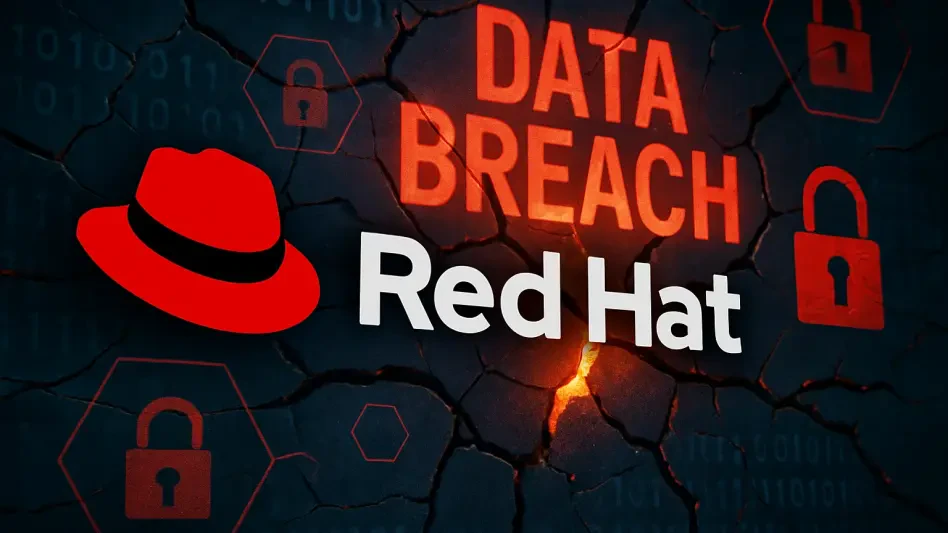In a startling development that has sent shockwaves through the cybersecurity world, Red Hat, a leading American software company and subsidiary of IBM, has confirmed a significant data breach targeting its consulting division. Known for its pioneering open-source solutions in hybrid cloud, AI, and automation, Red Hat serves as a cornerstone for countless enterprises globally. The incident, brought to light on October 2 of this year, involves claims by a hacking group named Crimson Collective, which alleges to have accessed sensitive internal data. This breach not only threatens customer trust but also raises profound questions about supply-chain security and the broader landscape of enterprise cybersecurity. As organizations increasingly rely on interconnected technology ecosystems, the ramifications of such a compromise could reverberate across industries, affecting government agencies, financial institutions, and healthcare providers alike. The urgency to understand the scope and impact of this event cannot be overstated, as it underscores the persistent vulnerabilities even within trusted tech giants.
Unveiling the Breach Details
The breach came into the public eye after Crimson Collective made bold claims via a Telegram channel launched on September 24 of this year, asserting unauthorized access to internal GitHub and GitLab repositories linked to Red Hat’s consulting arm. According to the hackers, their operation, conducted approximately two weeks prior to the disclosure, resulted in the extraction of a staggering 570 GB of compressed data from 28,000 repositories. Among the stolen assets are roughly 800 Customer Engagement Reports (CERs), which are detailed consulting documents containing critical client information such as architecture diagrams, system configurations, network maps, and access credentials. Additionally, the group claims to have obtained sensitive operational files, including authentication tokens, database connection strings, and CI/CD pipeline secrets. Such data, if exploited, could provide attackers with the means to infiltrate not just Red Hat’s systems but potentially those of its clients as well, amplifying the severity of the incident.
Further scrutiny of the hackers’ allegations reveals a calculated attempt to demonstrate the authenticity of their breach. Crimson Collective has shared directory listings of the compromised repositories and sample files through various online platforms, presenting evidence that appears to substantiate their claims. The nature of the stolen data, particularly the CERs, suggests a deep level of exposure, as these reports often serve as blueprints for client infrastructures. Beyond mere data theft, the hackers’ possession of operational secrets like VPN configurations hints at a capability for sustained unauthorized access. This situation poses an immediate threat to the confidentiality and integrity of affected systems, necessitating swift action from all involved parties to assess and mitigate potential damages.
Scope of Affected Entities and Emerging Risks
The breadth of organizations potentially impacted by this breach is alarming, spanning multiple critical sectors and including high-profile entities. Among the named clients in the exposed CERs are government bodies like the National Security Agency (NSA), financial giants such as Bank of America and JPMorgan Chase, telecom leaders including Verizon and AT&T, and healthcare institutions like the Mayo Clinic. This diverse list underscores the extensive reach of Red Hat’s consulting engagements and the corresponding scale of risk. With data reportedly covering client interactions over several years, the exposure could affect both current and past relationships, creating a complex web of vulnerabilities that attackers might exploit across different industries and operational timelines.
Compounding the concern is Crimson Collective’s assertion that they have already attempted to use the stolen credentials to access some of these clients’ infrastructures. This claim elevates the incident from a data leak to a potential active threat, where cascading breaches could disrupt operations on a massive scale. The detailed content of CERs, often embedding actionable intelligence like network topologies and authentication tokens, provides attackers with a roadmap to bypass traditional security measures. Such a scenario highlights the inherent danger of sensitive consulting data becoming a conduit for broader system compromises, emphasizing the urgent need for affected organizations to reevaluate their security postures and assume a state of heightened risk.
Red Hat’s Stance and Communication Challenges
In response to the breach, Red Hat has publicly acknowledged the security incident, emphasizing that it is confined to its consulting division and does not affect core product engineering or the broader software supply chain. The company has clarified that the compromised systems involve a GitLab instance used exclusively for consulting engagements, separate from its primary code hosting infrastructure. While Red Hat has initiated remediation efforts to contain the breach, specifics regarding the attack vector, the duration of unauthorized access, or the exact clients impacted remain undisclosed due to the ongoing investigation. This measured response aims to reassure stakeholders that the integrity of widely used products like Red Hat Enterprise Linux and OpenShift remains intact, yet it leaves critical gaps in understanding the full extent of the incident.
The limited transparency in Red Hat’s communications has sparked frustration among customers and cybersecurity experts seeking actionable insights to safeguard their own systems. Without detailed information on the breach’s scope or the nature of the compromised data, affected organizations face challenges in assessing their exposure and implementing targeted defenses. This lack of clarity contrasts sharply with the detailed evidence provided by Crimson Collective, creating a disparity between public claims and official statements. As trust is paramount in vendor-client relationships, Red Hat’s cautious approach, while understandable during an active investigation, risks undermining confidence among stakeholders who rely on timely and comprehensive updates to navigate such crises effectively.
Supply-Chain Security Under Scrutiny
Red Hat’s integral role in enterprise technology ecosystems amplifies the potential fallout from this breach, particularly concerning supply-chain security. As a provider of foundational tools like OpenShift and Red Hat Enterprise Linux, the company’s infrastructure is deeply embedded in countless organizational frameworks. The compromised data, if exploited, could serve as a gateway for attackers to pivot into client environments, bypassing perimeter defenses through trusted connections. This threat is especially pronounced given the nature of the stolen CERs, which often contain intricate details of client systems, offering malicious actors a direct path to critical assets and sensitive operations across interconnected networks.
Moreover, the incident sheds light on the systemic risks inherent in supply-chain dependencies, where a single breach can cascade through multiple layers of an organization’s ecosystem. The detailed system blueprints and operational secrets reportedly accessed by the hackers could facilitate privilege escalation and lateral movement within client networks, tactics often seen in sophisticated cyberattacks. This vulnerability underscores a pressing need for enterprises to reassess their reliance on third-party vendors and implement stringent controls to monitor and secure interactions with external partners. As supply-chain attacks grow in frequency and impact, the breach serves as a stark reminder of the interconnected risks that permeate modern IT environments.
Wider Implications for Cybersecurity Practices
This incident aligns with a troubling trend of supply-chain attacks, where adversaries target vendors or service providers to maximize their reach, echoing the devastating SolarWinds breach of 2020. Such strategies exploit the trust and interconnectivity inherent in business relationships, turning a single point of failure into a widespread threat. Red Hat’s breach reinforces the notion that even reputable technology providers are not immune to sophisticated attacks, urging enterprises to adopt a zero-trust architecture that assumes no entity is inherently secure. This approach, focusing on continuous verification and minimal privilege access, becomes essential in mitigating risks stemming from third-party engagements and compromised credentials.
Additionally, the breach exposes a critical oversight in the security practices of consulting divisions within tech firms, which often handle sensitive client data yet may not adhere to the same rigorous standards as core product teams. This disparity creates an attractive target for attackers seeking high-value information with potentially lower barriers to entry. The situation calls for a reevaluation of security protocols across all business units, ensuring uniform application of best practices like robust secrets management and regular credential rotation. By addressing these gaps, companies can better protect against breaches that exploit less-secured segments of their operations, safeguarding both their reputation and their clients’ trust.
Navigating the Aftermath and Future Safeguards
Reflecting on the events surrounding Red Hat’s data breach, the incident stands as a pivotal moment that exposed significant vulnerabilities within a trusted industry leader. The scale of the compromise, with vast amounts of sensitive data allegedly stolen by Crimson Collective, highlighted the fragility of even well-established cybersecurity frameworks. Affected organizations, spanning critical sectors, faced immediate risks of downstream breaches, while Red Hat’s limited disclosure added layers of uncertainty to an already tense situation. The event served as a sobering reminder of how interconnected technology ecosystems could amplify the impact of a single security lapse, challenging the assumptions of safety in vendor relationships.
Looking ahead, actionable steps must be prioritized to prevent similar incidents and rebuild resilience. Enterprises should proactively rotate credentials, audit access controls, and enhance monitoring for suspicious activities, assuming compromise as a precaution. Engaging with Red Hat for detailed impact assessments and forensic insights becomes crucial to tailor specific defenses. Beyond immediate responses, adopting long-term strategies like zero-trust principles and advanced secrets management tools will fortify defenses against evolving supply-chain threats. This breach ultimately catalyzed a broader industry dialogue on strengthening third-party risk management, urging all stakeholders to fortify their cybersecurity measures in an era of relentless digital threats.








